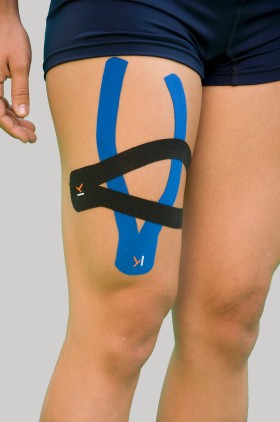
Kinesiotaping for quads
Many different types of quad injuries can occur:
Strains, overuse injuries, and ruptures can happen at either end of the muscle or in the muscle belly itself. Strains usually develop from overuse or overexertion and are most common in athletes who repeatedly stress the muscles by extending the knee, notably runners and cyclists. This repetitive stress causes failure at the junction between the muscle and its tendon and can progress to tears. A common example of a strain to the quadriceps tendon is Jumper’s Knee. This condition affects the quadriceps tendon just above the knee and is a direct result of repeated stress during multiple jumps. If pain is felt more towards the hips in the muscle belly, it is likely there has been a partial tear of the muscle itself. Pain is made worse with extension of the knee and to the touch.
Contusions are the most common quad injuries and are a result of a direct blow or blunt force to the thigh from an object or falling into an object. The contusion causes tissue damage and bruising. This often occurs in contact sports when participants collide and take a knee or helmet to the quad. Pain is generally constant and can be elicited by touch or any movement of the knee.
Muscle hernias can be caused by a sudden and forceful movement such as kicking, breaking into a sprint, or colliding with an object mid-sprint. Weakened or compromised quadriceps muscles will put the individual at greater risk for developing a muscle hernia. Typically a soft mass can be felt and is generally very tender to the touch.
Use KT Tape to relax the injured muscle and increase circulation to the area, as well as provide significant pain relief. Combine KT Tape with light progressive stretching, icing after activity, and appropriate rest in order to speed healing.
Read more news from our Physiotheraphy section.
Check out our Interviews section, every Tuesday a new story. Tomorrow read about Michal Debiec : “We have to take full risk”